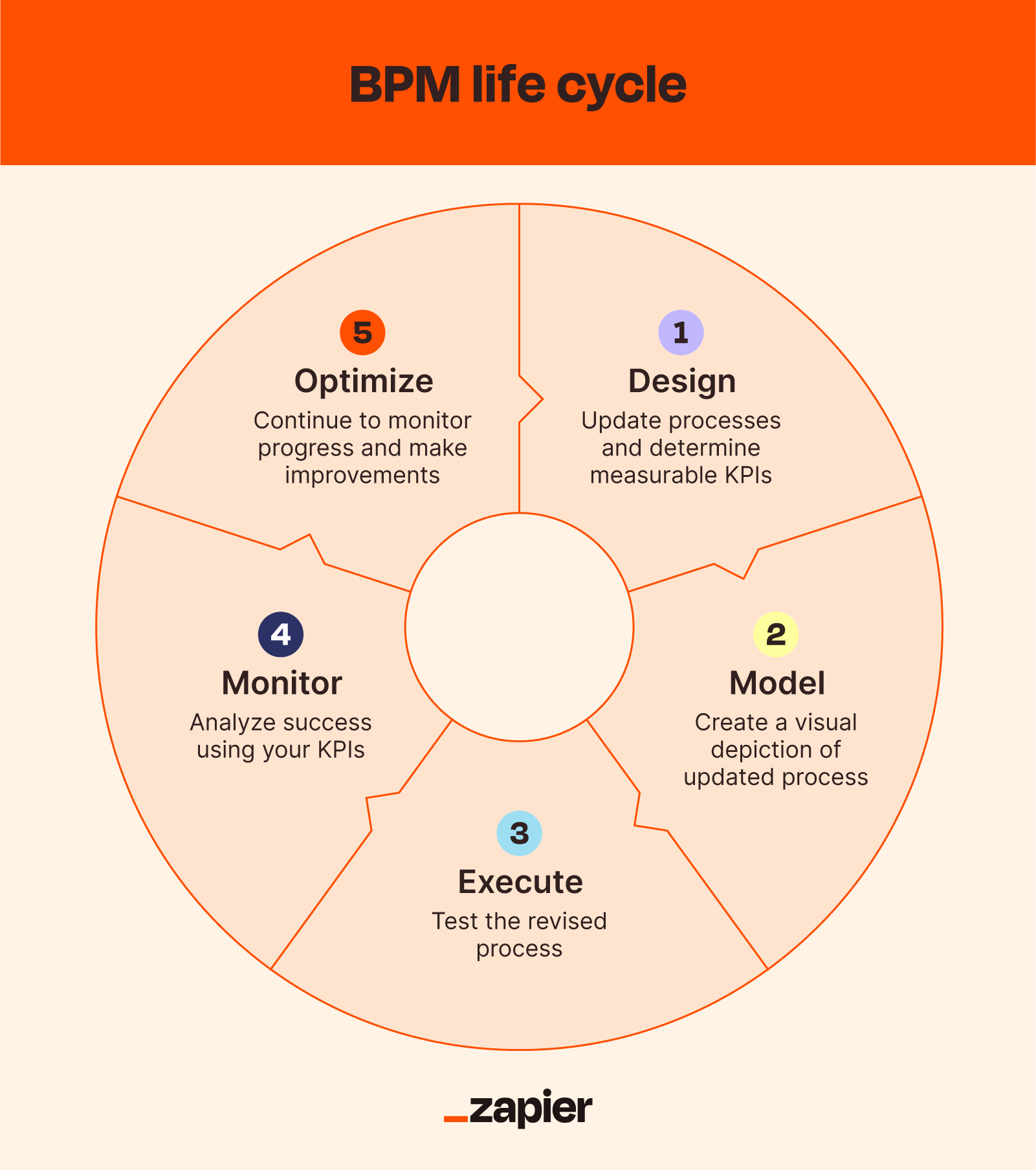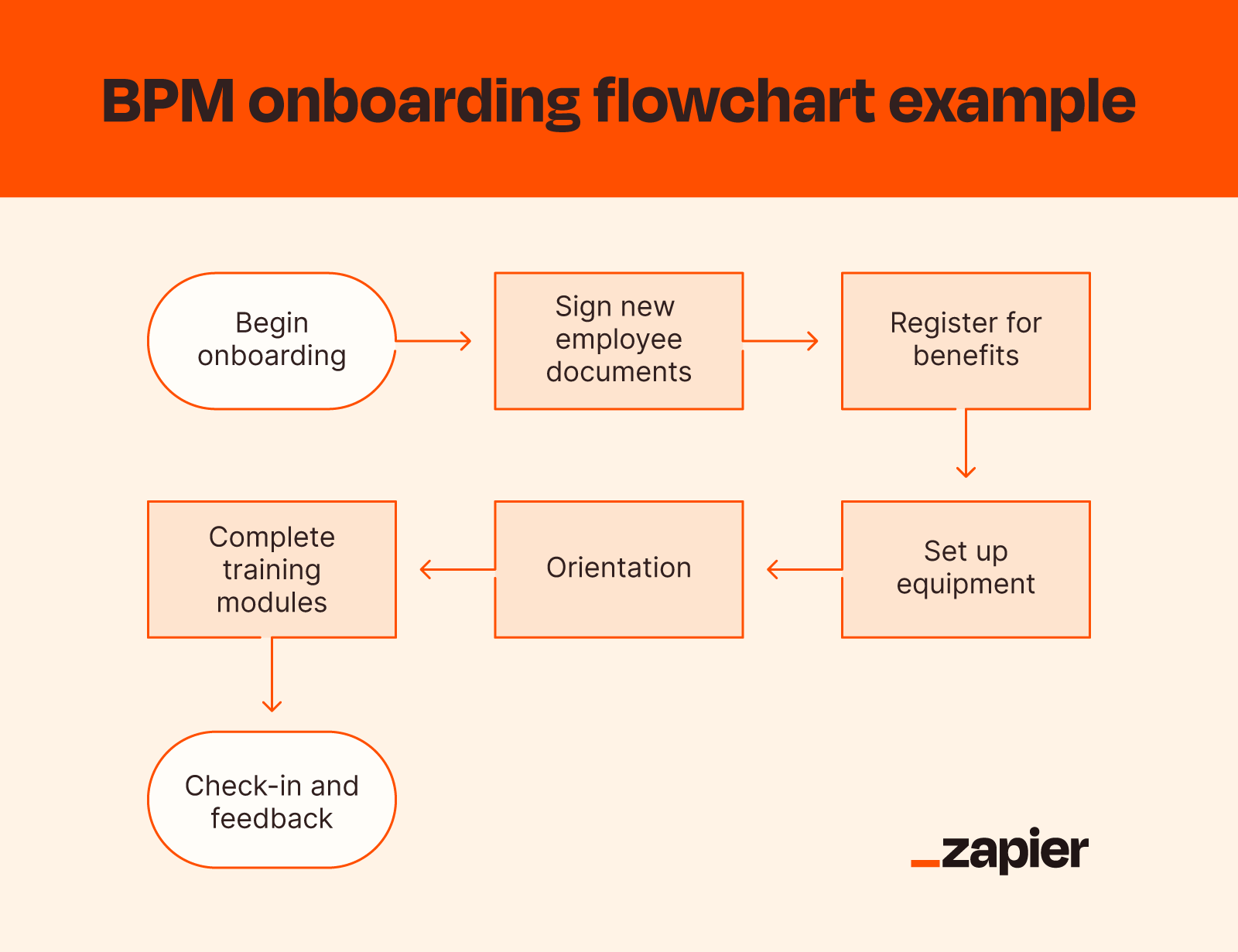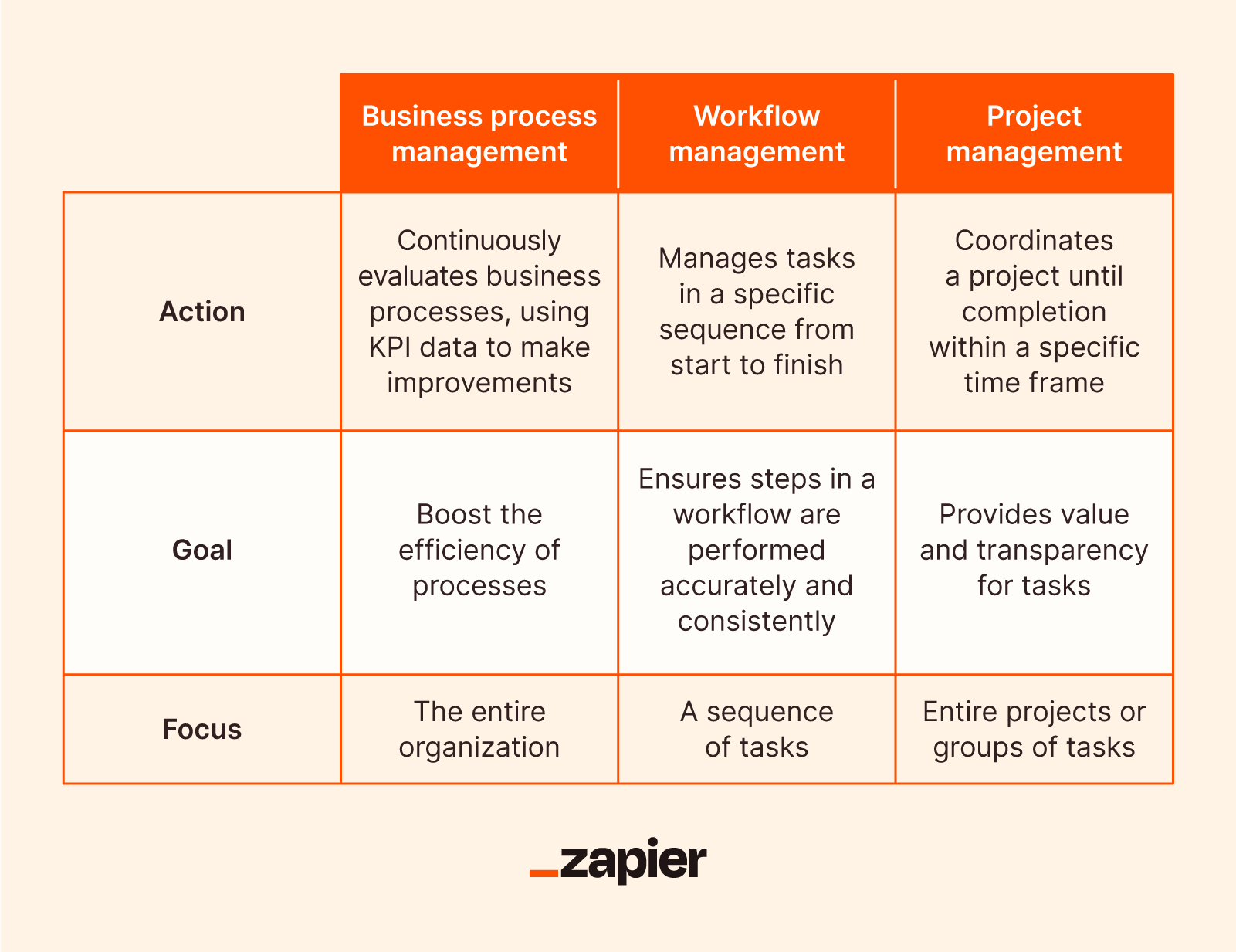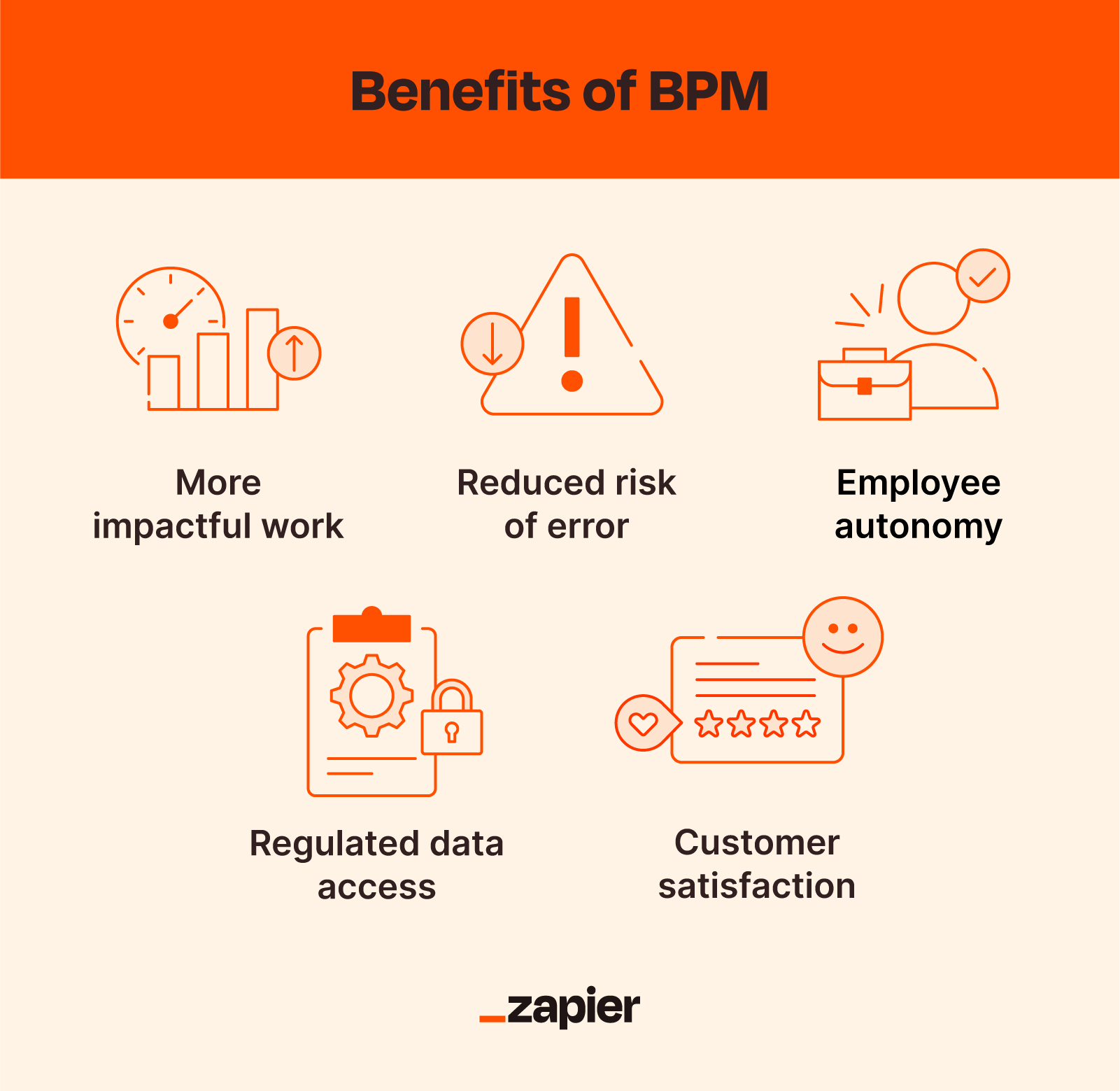My first job after college was for a highly disorganized digital marketing agency. On my first day, I was greeted with pure chaos—my manager wasn't even in the office when I arrived. For the first hour, I sat twiddling my thumbs and refreshing my email to see if any direction had come from above. With no processes in place, I was left to fend for myself and annoy my new coworkers with a million questions (if and when they were at their desks).
As my experience made glaringly obvious, business process management is crucial for just about every organization. In this guide, I'll break down the concept and provide tangible examples of ways you can apply it to your business.
Table of contents:
What is business process management (BPM)?
Business process management (BPM) streamlines and optimizes business processes, or repeatable tasks, to foster a more effective and efficient organization. The purpose of BPM is to save time, reduce errors, and keep a business running smoothly.
BPM is the very essence of how your business operates and delivers value. Think of processes like developing a new product, fulfilling an order, managing customer service, or even onboarding a new employee. Each of these operations involves all sorts of tasks, approvals, and interactions, often spanning departments. Well-structured BPM keeps all these little micro-tasks organized into clear, repeatable steps, leading to predictable and consistent results. This structure not only aids in resource allocation but also identifies potential bottlenecks and areas for improvement.
Business process management lifecycle steps
BPM includes the following five stages:
Design
Model
Execute
Monitor
Optimize

Step 1: Design
Take a good, honest look at your current processes and see where you're falling short. Key performance indicators (KPIs) can give you a way to track your progress. Here are some examples:
Average response time for customer support tickets
Percentage of products with defects
Employee turnover rate
If any of these numbers fall short of the industry standard, you'll want to revisit the processes tied to them.
Step 2: Model
As the adage goes, a picture's worth a thousand words. Visualizing your processes will allow people in your organization to digest the game plan more easily. Here are some data visualization methods to try:
Petri net: Best for modeling simultaneous processes
Gantt chart: Best for showing a process schedule
Flowchart: Best for showing a process in sequential order (flowchart software will make your life easier)
As you design the model, make sure you answer these questions that stakeholders might have:
Who is the subject of the process?
Where does the process start and end?
How is the updated process more efficient and effective?
Of course, a model is just a starting point—you might also create separate charts for the processes within each step of the process you're redesigning, as well as detailed documentation about your new processes.

Step 3: Execute
So you have a new and improved process with a shiny bow on top—now it's time to deploy it. As you prepare to do so:
Begin with a smaller group, so you can easily correct any hiccups before implementing it across the organization.
Establish an implementation team, and give each member specific roles.
Look for areas that you could automate in the new process.
Consult with employees to get their feedback before rolling it out to the entire organization.
Step 4: Monitor
Next, confirm your new process works by tracking the KPIs you established in the design phase. The way you monitor will depend on what you're tracking, and you'll want to track both qualitative and quantitative data. For example, if you were focused on improving employee turnover rate, you may send out a new employee feedback survey after implementing the new process, but you'll also want to keep an eye on the turnover rate itself.
Step 5: Optimize
Last but not least, continue to make improvements to the process as time goes on. For example, if negative feedback from the new employee survey rises above a certain threshold again, you may want to look into areas of concern based on the responses you receive.
As you look for improvement opportunities, ask yourself:
Have any organizational changes affected the process? For example, if a team structure changes, it's possible that new steps will be required or new people will need to be involved.
Are all steps in the process still necessary? Did you add an app to your tech stack that removes the need for a certain step? Did you eliminate a specific product requirement that means you can cut down on certain steps?
Is it possible to automate any of the steps? Now that you've done everything manually, what are the repetitive tasks that don't require a human touch? What can you delegate to the robots?
Approaches to business process management
Depending on your approach to dog training, you'll either reach for the peanut butter or the spray bottle, right? Same goes for BPM: there are a number of different approaches, each of which is fit for specific circumstances.
Human-centric BPM
Human-centric BPM addresses the processes performed by people in the organization. It's about work that can't (or at least hasn't yet) been replaced by robots.
You might take a more human-centric approach when focusing on:
Report analysis
Language translation
Task management
Content creation
Document-centric BPM
Document-centric BPM is about getting important documents to the finish line and making them accessible to the rest of your organization—think tracking, verification, and organization.
You'll likely focus on document-centric BPM for matters like:
Document signature requests
Digital image processing and data extraction
Integration-centric BPM
Integration-centric BPM is about improving cross-platform processes. If employees complain about needing to jump between 15 tools to complete a day's work, this is an area to focus on.
Here are some tasks that often require you to bounce between several tools, which means you can use integration-centric BPM to improve them:
This kind of BPM benefits from an automation tool like Zapier, which can connect all of your apps, eliminating manual work and allowing you to scale more easily.
Business process management vs. workflow management vs. project management
There's a lot of functional overlap between BPM, workflow management, and project management, but they differ in the following ways:
Workflow management means supervising a sequence of tasks.
Project management refers to the supervision of entire projects (or groups of tasks together).
Business process management deals with all of a company's processes across different projects, teams, and departments.

While workflow and project management are important pieces of the organizational efficiency puzzle, BPM focuses on the big picture.
What are the benefits of business process management?

It's a lot of upfront work, so why should you devote your company's precious resources to BPM?
More impactful work: Streamlining processes lets you zero in on more impactful work. When my team implemented a social media automation tool that allowed me to schedule posts across all platforms in advance, I could focus my time and energy on creating quality content instead of uploading posts.
Reduced risk of error: Mistakes happen. It's inevitable. But when processes are a mess, the chances of tripping up increases. After we ironed out our social media processes, the odds of me releasing a post on the wrong day or making a typo dwindled.
Employee autonomy: Muddled processes can lead to micromanagement, delays, and just plain confusion. But with everything laid out clearly, employees can take the reins with confidence.
Regulated data access: BPM isn't just about processes; it's a gatekeeper, too. I can't count the times I'd gear up to post, only to find I was locked out of an account. But with our processes revamped, our password manager made access smooth.
Customer satisfaction: The people in your company aren't the only ones who will feel the benefits of BPM. Fine-tuned internal processes result in better products, better relationships, and, ultimately, improved customer experience.
7 BPM best practices
1. Define clear objectives
Before diving into BPM, ask yourself: "what are we trying to achieve?" Are you looking to reduce costs, improve efficiency, or enhance customer satisfaction? Maybe all three? Pinpointing these objectives will guide your BPM journey and ensure you're not just wandering aimlessly in the vast world of processes.
Consider setting SMART objectives:
Specific
Measurable
Achievable
Relevant
Time-bound
Let's break it down with an example.
Meh objective: "Let's boost our sales."
Sounds cool, but it's a bit like saying, "I want to be famous." Ok, but how? Through viral TikToks or inventing the next big thing since sliced bread?
SMART objective: "We're aiming to pump up our online sales by 15% in the next quarter. We'll rev up our digital ads and give our online store a little TLC."
See the difference? This objective is laser-focused (boost online sales), has a clear target (by 15%), feels doable (with some ad tweaks and website love), aligns with the digital age (online shopping), and has a timeline (next quarter).
By setting SMART objectives, you're not just throwing darts in the dark. You're giving your team a clear target, ensuring everyone's on the same page and ready to rock it.
2. Map out existing processes
Imagine trying to assemble a puzzle without seeing the picture on the box. That's what it feels like to dive into BPM without knowing where your business is at. Start by documenting the current state of things. You might be surprised at the inefficiencies you uncover.
Use tools like flowcharts or process diagrams. And no, this isn't just an excuse to play with colorful markers and sticky notes. Visual representations can help everyone in the organization understand the process and identify areas for improvement.
3. Standardize processes
There's comfort in consistency. Standardization not only reduces errors but also makes onboarding new team members a breeze. Here are some tips and tricks to help you standardize your processes:
Create templates: Whether it's a project proposal, a report format, or a meeting agenda, having a go-to template ensures consistency.
Develop checklists: For complex processes, checklists can provide an outline, so steps are followed in the right order and nothing is missed.
Implement approval workflows: For processes that require multiple levels of review or approval, standardized approval workflows ensure that every piece of content or decision goes through the necessary checks.
4. Embrace automation and AI
Let's face it: some tasks are just tedious. And that's where automation shines. Whether it's sorting emails or scheduling social media posts, automation tools can handle the mundane, freeing up your team for more strategic endeavors. And with AI, you can gain immediate insights and predictions that were once the stuff of sci-fi (or at least took humans days to figure out).
Identify tasks within your processes that are repetitive and time-consuming. These are prime candidates for automation. Tools like Zapier can help connect your apps and automate workflows, freeing up human resources for more complex tasks that require a personal touch.
5. Prioritize cross-departmental collaboration
Silos belong on farms, not in businesses. If departments are working in isolation, you're missing out on valuable insights and collaboration. Encourage teams to communicate and collaborate on processes that overlap or intersect.
Hold regular interdepartmental meetings to discuss processes, challenges, and improvements. This not only fosters a culture of collaboration but also ensures that processes are aligned across the organization.
6. Invest in training
The best processes in the world won't mean much if your team doesn't know how to use them. Regular training sessions ensure everyone's on the same page and can adapt to any new changes or tools introduced. Here are some ideas to keep the training interesting:
Interactive workshops: Get hands-on with the tools and processes. Let your team play around, make mistakes, and learn in a controlled environment.
Buddy system: Pair newbies with BPM veterans. This mentorship approach allows for real-time feedback and guidance.
Regular check-ins: Schedule regular check-ins to see how your team is adapting to the new processes. This is an opportunity to address any challenges they might be facing and offer additional training if needed.
Process gamification: Set up challenges, leaderboards, and rewards. People are more likely to engage when there's a competitive element involved.
Access to resources: Whether it's detailed manuals, video tutorials, or a dedicated help desk, ensure your team has resources they can turn to when in doubt. And make sure these resources are easily accessible.
7. Review and iterate
Sticking to the status quo might feel comfortable, but in the dynamic world of business, it's a recipe for stagnation. Here's how you can ensure your processes remain agile and effective:
Schedule audits of your processes to identify areas for improvement. This could be quarterly, biannually, or annually, depending on the nature of the process.
Keep an eye on industry best practices. If competitors or similar industries are adopting new methods, it might be time to consider if they're right for you.
Use data analytics tools to monitor the efficiency and effectiveness of your processes. Look for patterns, bottlenecks, or areas of delay.
Test new processes in a controlled environment or with a smaller team. This allows you to gauge its effectiveness without disrupting the entire organization.
Document everything every time you make a new change. This creates a record that can be referred back to, ensuring everyone is aware and can understand the rationale behind the change.
Remember, the goal isn't to change just for the sake of change. It's about making sure your processes are as efficient, effective, and relevant as possible in a constantly shifting landscape.
Examples of business process management
I struggle to think of any area of business where BPM couldn't be applied. Here's how some of your essential departments can use it.
Marketing: Human-centric approach
Calling on my own professional experience, the marketing department can get… hectic. Many systems and processes need to collaborate for marketing to work, from lead management to analytics to email scheduling. To make it all work, you need good task management.
The problem: Project management software highlights that 43% of marketing deadlines are missed. Managers identify a disorganized content approval process as the biggest culprit.
Design: The marketing manager creates a new workflow detailing exactly which members of the team need to approve content pieces and in what order.
Model: The department creates a flowchart, labeled by position and team member name, to visually present the new workflow.
Execute: The marketing department integrates the workflow with only one team to start to evaluate its effectiveness, then integrates it across the whole department.
Monitor: After a couple of months, the project management software shows that the marketing department is reaching their deadlines an average of 26% more often than they were prior to the implementation of the new workflow.
Optimize: After determining that an editor should comb through and approve each piece of content again after initial edits are complete, the marketing department adds this step to the workflow and pushes back deadline expectations to accommodate.
Finance: Document-centric approach
In many organizations, the finance department spends a lot of time processing requests and forms.
The problem: The current invoice approval process is handled entirely by employees in the finance department. Approval currently takes an average of 16 days from receipt to payment.
Design: The finance department purchases software to automate the invoice approval process, cutting the need for so much manual entry.
Model: The department illustrates the steps of the process that the new software automates and which will still be handled manually.
Execute: The team first implements the software for one of the five employees that handle invoice approvals to evaluate its efficiency.
Monitor: Average processing time decreases to six days using the new software. After a few months of use, some team members bring to your attention additional parts of the process that can be automated.
Optimize: You expand the software's reach to further automate the invoice approval process, decreasing average processing time to four days.
Human resources: Integration-centric approach
Organizational data can't always be kept in one place, which can slow down processes. Integrations can help unify these data sources, making processes easier.
The problem: Time tracking shows that HR managers spend four hours per week responding to PTO requests. A survey of these managers shows that the need to bounce back and forth between several different applications slows the process down.
Design: The department head implements a new tool that integrates the organization's calendar app, HR platform (where PTO is requested), and project scheduling app.
Model: The department head compiles screenshots from their own desktop into a presentation to communicate how HR managers can use information from all of those apps to quickly respond to PTO requests.
Execute: HR launches the new software in only one department to test out its functionality before scaling it across the organization.
Monitor: Time tracking shows that HR managers now spend three fewer hours per week responding to PTO requests thanks to the new integrations. However, six months later, another survey of HR managers points to some ways that the process could be automated.
Optimize: HR installs and integrates another software that recommends each PTO request be "approved" or "denied" based on company resource availability and the employee's remaining allocated PTO hours, cutting another 15 minutes per week from the time it takes to respond to requests.
Business process management and automation
When it comes to BPM, automation and integration are the keys to the kingdom. From cutting down on administrative tasks to connecting all the apps you already use, automation allows you to focus on achieving your business goals. Here are more ideas for how to automate your team's work as part of BPM:
This article was originally published in September 2022. The most recent update, with contributions from Michael Kern, was in October 2023.









